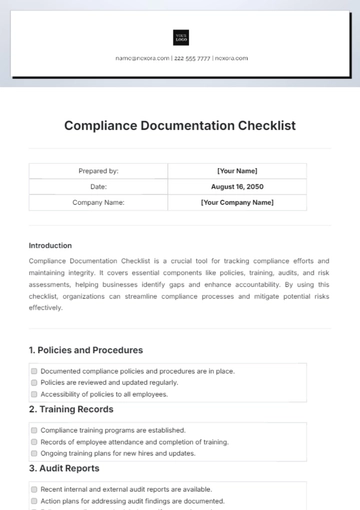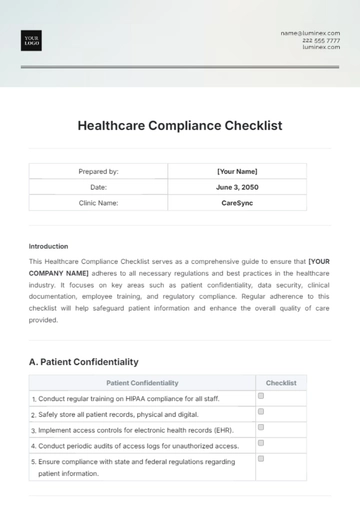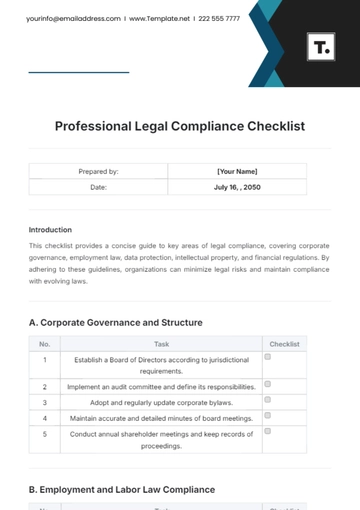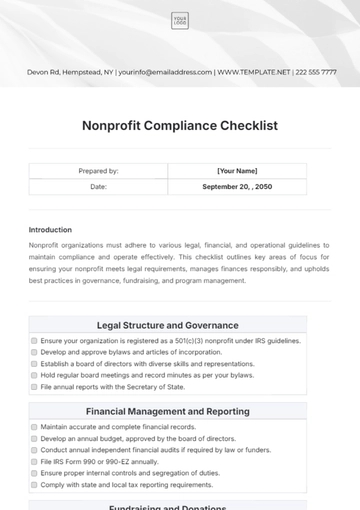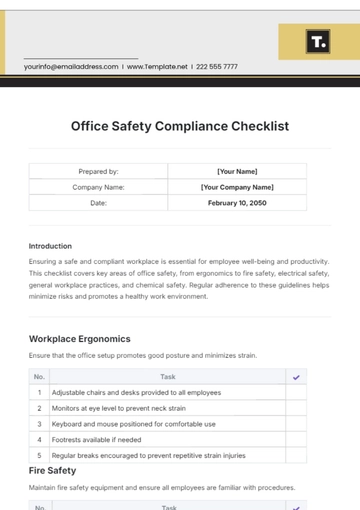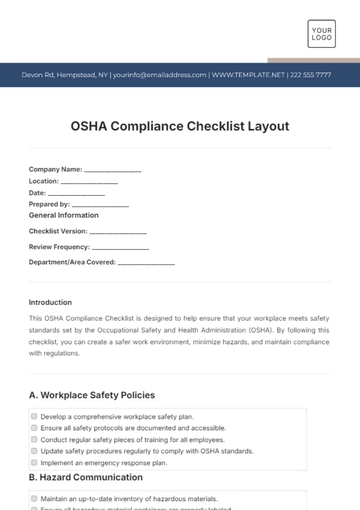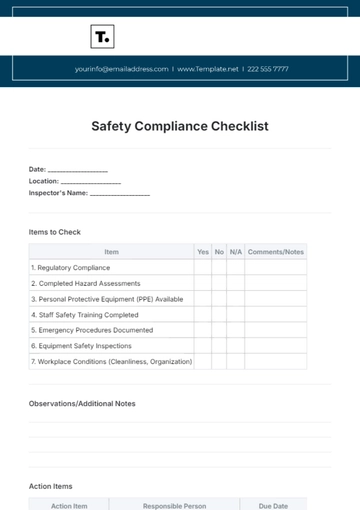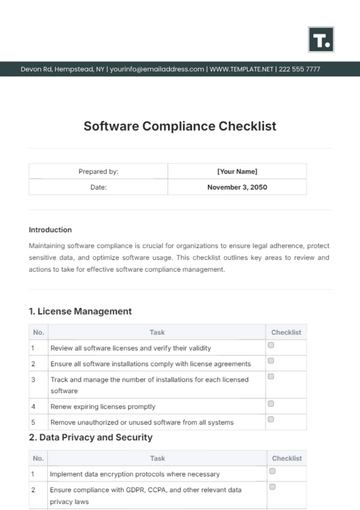Free Facilities Management Compliance Checklist

I. Compliance Overview
Objective: Ensure that [YOUR COMPANY NAME] adheres to regulatory requirements and best practices in facilities management to maintain safe, efficient, and compliant facilities.
Responsible Party: [YOUR NAME], Facilities Manager
Date of Last Review: [DATE]
Next Scheduled Review: [NEXT REVIEW DATE]
II. Building Safety and Maintenance
Building Inspections:
Schedule regular inspections to identify maintenance issues, safety hazards, and compliance concerns.
Inspect structural elements, utilities, and fire protection systems for signs of damage or malfunction.
Evaluate cleanliness and organization to prevent trip hazards and fire risks.
Document findings and prioritize corrective actions based on severity.
Safety Equipment:
Ensure proper installation, maintenance, and testing of safety equipment.
Conduct regular inspections to verify equipment functionality and accessibility.
Train employees on safety equipment usage and emergency procedures.
Establish a maintenance schedule and documentation process for compliance.
Emergency Exits and Evacuation Plans:
Maintain clear and unobstructed emergency exits and routes.
Install signage indicating exit locations and evacuation routes.
Develop and practice evacuation plans with employees through regular drills.
Review and update evacuation plans periodically to reflect changes in building layout or occupancy.
III. Environmental Compliance
Hazardous Materials Management:
Store hazardous materials securely in designated areas with proper containment measures.
Train employees on safe handling procedures and emergency response protocols.
Dispose of hazardous waste through authorized channels in accordance with regulations.
Maintain records of hazardous materials usage, storage, and disposal for regulatory compliance.
Indoor Air Quality:
Regularly monitor indoor air quality parameters such as temperature, humidity, and air contaminants.
Ensure proper ventilation systems are in place and functioning effectively.
Conduct routine maintenance of HVAC systems, including filter replacements and duct cleaning.
Address indoor air quality concerns promptly through ventilation adjustments or air purification measures.
Energy Efficiency:
Conduct energy audits to identify opportunities for energy conservation and efficiency improvements.
Implement energy-saving measures such as LED lighting retrofits and programmable thermostat installation.
Optimize HVAC systems through equipment upgrades and regular maintenance.
Invest in building automation systems to control energy usage and optimize building performance.
IV. Accessibility Compliance
ADA Compliance:
Verify accessible parking spaces are available and properly marked with signage.
Ensure entrances are accessible with ramps or elevators for wheelchair users.
Provide accessible restrooms equipped with grab bars and adequate space for manoeuvrability.
Offer accommodations such as Braille signage or assistive listening devices for individuals with disabilities.
Accessibility Audits:
Schedule regular audits to assess compliance with ADA accessibility standards.
Identify barriers to accessibility such as narrow doorways or inaccessible pathways.
Prioritize corrective actions based on audit findings to improve accessibility.
Train staff on accessibility requirements and procedures for accommodating individuals with disabilities.
V. Regulatory Compliance
Building Codes and Regulations:
Regularly review local building codes and zoning regulations to ensure compliance.
Obtain necessary permits and approvals for facility construction, renovation, or changes in land use.
Consult with architects, engineers, or legal experts as needed to interpret and apply building codes.
Maintain documentation of permits, inspections, and compliance efforts for regulatory purposes.
Health and Safety Regulations:
Establish policies and procedures to ensure compliance with OSHA regulations for workplace safety.
Provide training to employees on safety protocols, hazard communication, and emergency response.
Conduct regular inspections of facilities to identify and address potential health and safety hazards.
Keep records of safety training, inspections, and incident reports to demonstrate compliance with regulations.
VI. Emergency Preparedness
Emergency Response Plans:
Identify potential emergency scenarios relevant to the facility and surrounding area.
Develop detailed response plans outlining procedures for each type of emergency.
Assign roles and responsibilities to personnel for executing emergency response actions.
Communicate emergency response plans to all employees and provide training on procedures.
Emergency Contacts and Resources:
Compile a list of emergency contacts, including local fire and police departments, hospitals, and utility companies.
Ensure emergency contact information is readily accessible to all employees and posted in visible locations.
Maintain emergency supplies such as first aid kits, fire extinguishers, and emergency lighting.
Regularly review and update emergency contact information and resources to ensure accuracy and effectiveness.
VII. Maintenance Management
Preventive Maintenance:
Create a schedule for routine maintenance tasks based on manufacturer recommendations and industry best practices.
Assign responsibility for conducting maintenance activities to qualified personnel or external service providers.
Keep detailed records of maintenance performed, including dates, tasks completed, and any issues identified.
Regularly review and update the preventive maintenance program to address changing needs and optimize performance.
Work Order Management:
Establish a centralized system for receiving maintenance requests, such as an online portal or work order management software.
Prioritize work orders based on urgency, impact on operations, and available resources.
Assign tasks to appropriate personnel or contractors and track progress towards resolution.
Communicate updates on work orders to requestors and stakeholders and ensure timely completion of tasks.
VIII. Continuous Improvement
Performance Monitoring:
Define key performance indicators (KPIs) relevant to facilities management, such as maintenance backlog, energy consumption, and occupant satisfaction.
Collect data on KPIs through regular inspections, meter readings, surveys, and other monitoring methods.
Analyze KPI data to identify trends, patterns, and areas for improvement in facilities management practices.
Use KPI insights to develop action plans and initiatives aimed at optimizing facility performance and enhancing operational efficiency.
Feedback Mechanisms:
Implement multiple channels for collecting feedback, including suggestion boxes, surveys, and meetings with stakeholders.
Encourage building occupants, maintenance staff, and other stakeholders to provide feedback on their experiences and observations.
Regularly review feedback received and prioritize addressing issues or concerns raised by stakeholders.
Communicate actions taken in response to feedback and involve stakeholders in the improvement process to foster engagement and accountability.
IX. Signature
By signing below, you acknowledge that you have reviewed and understand the contents of this facilities management compliance checklist and affirm [YOUR COMPANY NAME]'s commitment to maintaining compliant and well-managed facilities.

Facilities Manager
[YOUR COMPANY NAME]
Date: [DATE]
- 100% Customizable, free editor
- Access 1 Million+ Templates, photo’s & graphics
- Download or share as a template
- Click and replace photos, graphics, text, backgrounds
- Resize, crop, AI write & more
- Access advanced editor
Discover unparalleled ease in ensuring facility compliance with the Facilities Management Compliance Checklist Template from Template.net. This meticulously crafted resource is both editable and customizable, empowering you to tailor it to your specific needs effortlessly. Seamlessly editable in our AI Editor Tool, it streamlines compliance processes for enhanced efficiency.
You may also like
- Cleaning Checklist
- Daily Checklist
- Travel Checklist
- Self Care Checklist
- Risk Assessment Checklist
- Onboarding Checklist
- Quality Checklist
- Compliance Checklist
- Audit Checklist
- Registry Checklist
- HR Checklist
- Restaurant Checklist
- Checklist Layout
- Creative Checklist
- Sales Checklist
- Construction Checklist
- Task Checklist
- Professional Checklist
- Hotel Checklist
- Employee Checklist
- Moving Checklist
- Marketing Checklist
- Accounting Checklist
- Camping Checklist
- Packing Checklist
- Real Estate Checklist
- Cleaning Checklist Service
- New Employee Checklist
- Food Checklist
- Home Inspection Checklist
- Advertising Checklist
- Event Checklist
- SEO Checklist
- Assessment Checklist
- Inspection Checklist
- Baby Registry Checklist
- Induction Checklist
- Employee Training Checklist
- Medical Checklist
- Safety Checklist
- Site Checklist
- Job Checklist
- Service Checklist
- Nanny Checklist
- Building Checklist
- Work Checklist
- Office Checklist
- Training Checklist
- Website Checklist
- IT and Software Checklist
- Performance Checklist
- Project Checklist
- Startup Checklist
- Education Checklist
- Home Checklist
- School Checklist
- Maintenance Checklist
- Planning Checklist
- Manager Checklist
- Wedding Checklist
- Vehicle Checklist
- Travel Agency Checklist
- Vehicle Inspection Checklist
- Interior Design Checklist
- Backpacking Checklist
- Business Checklist
- Legal Checklist
- Nursing Home Checklist
- Weekly Checklist
- Recruitment Checklist
- Salon Checklist
- Baby Checklist
- Equipment Checklist
- Trade Show Checklist
- Party Checklist
- Hospital Bag Checklist
- Evaluation Checklist
- Agency Checklist
- First Apartment Checklist
- Hiring Checklist
- Opening Checklist
- Small Business Checklist
- Rental Checklist
- College Dorm Checklist
- New Puppy Checklist
- University Checklist
- Building Maintenance Checklist
- Work From Home Checklist
- Student Checklist
- Application Checklist



